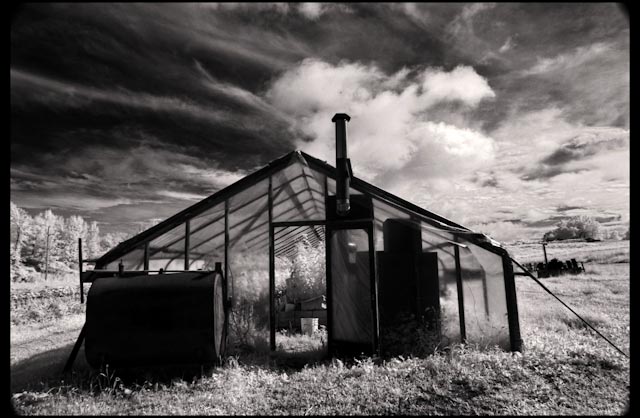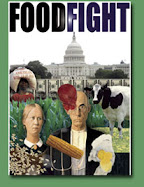May 2009
Most cold climate seeds are designed to sleep their way through winter, allowing temperature and moisture to prompt germination in spring. Weeds are thought to have such an advantage in the garden because they've experienced this dormancy naturally. When we start our own seeds, we're often instructed to methodically trick them into reacting as though they've experienced winter, in order to urge their germination. Scarification (nicking a seed coat with a razor prior to sowing) is simply mimicking the cracking that occurs in a seed hull after a season of freezing and thawing. So, why not just sow your seeds outdoors in autumn, and see what happens? Well, you could, but you'd be sure to lose some to wind, birds, and burrowing critters. But we've all seen volunteer squash come up in the compost, right?
Winter sowing is a method of setting seeds outdoors in lidded containers to allow them to scarify and stratify naturally for spring. Although this method is really helpful for specialized northern plants, success has been experienced with warmer climate plants, as well. I happen to have a lot of wildflower seeds with picky instructions, and I'm also totally interested in experimenting with some tomatoes just to see what can be achieved in the hoop house without heat. This is a big issue where I live (at least to me) because a lot of the tomatoes that we buy over the summer are started really early by heating a green house with oil, propane, or wood - just because the public (myself included) can't wait for tomatoes to be ready in September, only to disappear within a month. I'm curious if winter sown tomatoes grow into stronger and more cold tolerant plants that can withstand some of the temperature swings we have in April and May. If so, then maybe they can be protected with an extra layer of plastic instead of being heated, and still produce early.
Pomykala Farm's tomatoes and heater
At wintersown.org (the best instructions for winter sowing anywhere) Trudi recommends saving plastic chinese food containers, cool whip tubs, and 2 liter soda bottles for sowing. If you live where I do (in the middle of nowhere) and eat like I do (not much soda and cool whip) look for foil catering trays - at Costco they're 30/$6.36. I happen to have a lot of plastic starter flats with lids on hand.
I set the whole operation up on the kitchen floor because it's mop-able. The trays were perforated, but I made sure to cut slits in the lids for air transpiration - I have fried countless little plants by not allowing the heat and moisture an obvious escape route.

each flat was seeded, and larger seeds like these Turk Cap Lilies were covered with soil
I made duct tape labels for each tray, written in permanent marker

I set all the flats outside on tables and makeshift tables for the time being. I made sure to avoid places where our steep roof dumps snow (I woke up to no less than 7 'explosions' last night...)
each lid then got weighted down with a piece of wood in case of high winds
and lastly, I made a diagram of what I planted where, as I've never had much luck with labels
Here are the wildflowers and natives that I sowed: Nodding Onion, Rose Mallow, Obedient Plant, Jacob's Ladder, Anise Hyssop, and Turk's Cap Lily. I also sowed 2 flats of Alpine strawberries, Blue Solaize leeks and 6 kinds of tomatoes: Moonglow, Green Zebra, Nyagous, Crnkovic Yugoslavian, Opalka, and Black from Tula, all from Seed Savers Exchange. Will winter sown tomatoes be more resistant to blight?
last season's tomatoes finally got the blight in late August
I dont feel even close to done, but I ran out of (thawed) soil. Can I sow right into plug trays? Can I sow trays in the hoop house without using lids if I regulate the moisture? I plan to try it all, as I have little use for seeds that need to be started indoors - what a drag. And what great gifts these flats would make - I can think of friends and family that would love this little experiment in their own yard, especially if they didn't have to do any of the work. Can you imagine how great it would be to start all of your seeds now? no lights, no watering, no getting the timing wrong. Have I convinced you to try? C'mon, just a quarter pack of tomato seeds in a cool whip tub...

























Nice post on winter sowing. I'm really curious about the tomatoes and how they'll do. The B and W photo of the greenhouse is stunning, while the chicken inspecting your notebook made me grin. Glad I found your blog.
ReplyDeleteI will be interested in following up to see what occurs with all your flats. Did the hen approve?
ReplyDeleteMiss Rita, my cross-beaked hen, is the only chicken I have who approves of everything I do. The rest of them are quite suspicious. And they try to eat everything that I plant, so the real question is whether or not the tomatoes will make it to be eaten by the girls!
ReplyDeleteWhat an interesting project. I love the picture of the hen checking out what will be on offer in the spring! -Jean
ReplyDeleteA great post JP! I have enjoyed many seedlings early spring by just letting some lettuce bolt to seeds... I have found arugula, lettuce, bok choy and kale do great with this lazy and natural method. Miss Rita looks quite interested in your diagram! Look forward to follow up posts on your winter seedlings! Carol
ReplyDeleteHi Jp for many years now, probably 12 or so, I have been letting some of each variety, of lettuce go to seed in the garden. I tag at least one of each variety to let go to see. I have very early lettuce growing everywhere in the spring. Every year I have at least 5 varieties that come up so early. I harvest lots of it. I think it comes up in late April because I have notes of harvesting lots in early May. One year I had a self-sown tomatoe come up. I didn't even notice it until it had little tomatoes. We are zone 4. Great post -
ReplyDeleteJP, My experience plays into the idea of letting some plants self seed for next season. I make it a habit of allowing some of my cilantro go to seed and I always have very early sprouting plants in the spring - I'm in CT zone 5. I've also held small lettuce and cilantro plants in a cold frame over winter, and these always provided very early spring cuttings. And, I usually have a few volunteer, self-seeded tomatoes - last year volunteer cherry tomatoes were the only of this type that actually produced fruit.
ReplyDeleteI'm pretty sure I've had volunteer tomatoes as well, which gives me hope... I will definitely keep up the progress posts.
ReplyDeleteThis is a really informative posting about winter sowing. I have had volunteer yellow plum tomatoes that fruited, and squash in the compost pile that didn't. You have encouraged me to give this technique more thought.
ReplyDeleteHi JP,
ReplyDeleteThis is very interesting method. I’m sure that all seeds will germinate, but will they do it soon enough, I just can’t wait to see.
I was just thinking to do similar experiment in my greenhouse (not heated), as leaving plants to self seed in the garden is not an option for me - I would probably mistake them for weed and that would be the end of them.
vrtlarica: the unheated greenhouse has my curiosity peaked, too. If you were to do it just as is with the lids on, then it stands to reason that you're just shifting the whole process a few zones. I'm skeptical of that idea, though, as the hoop house can get so hot on a sunny day, that I'm afraid the lids would cause the seedlings to lose moisture faster than I could moderate. Also, with or without the lids, you're taking away the natural amount of precipitation the plants would receive and might have to regulate water differently in a different manner than you are used to. But that's why it's an 'experiment'.
ReplyDeleteI am doing winter sowing for the first time, mostly perennials. It's an interesting idea to winter sow tomatoes. Good luck to you!
ReplyDeleteHi JP. Love your blog! Especially the photos. Great work!
ReplyDeleteI'm hoping to get some small cold frames built this year so will be following your "experiments" with interest. I'm in zone 3 and any way to extend the growing season is of interest for me!
Cheers,
Janice